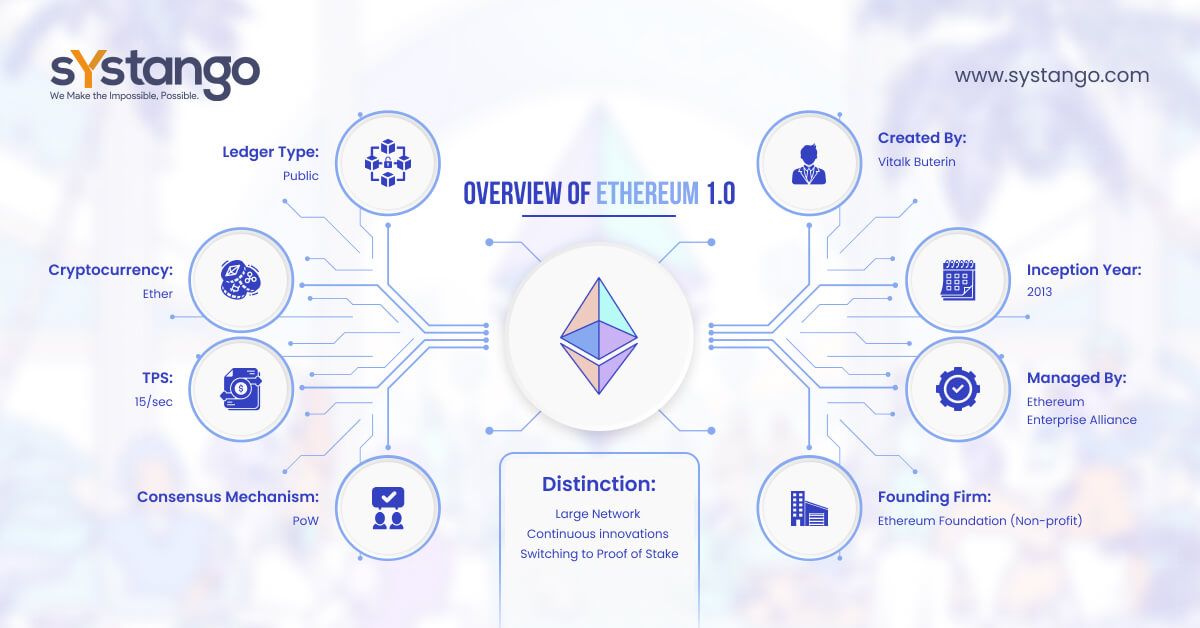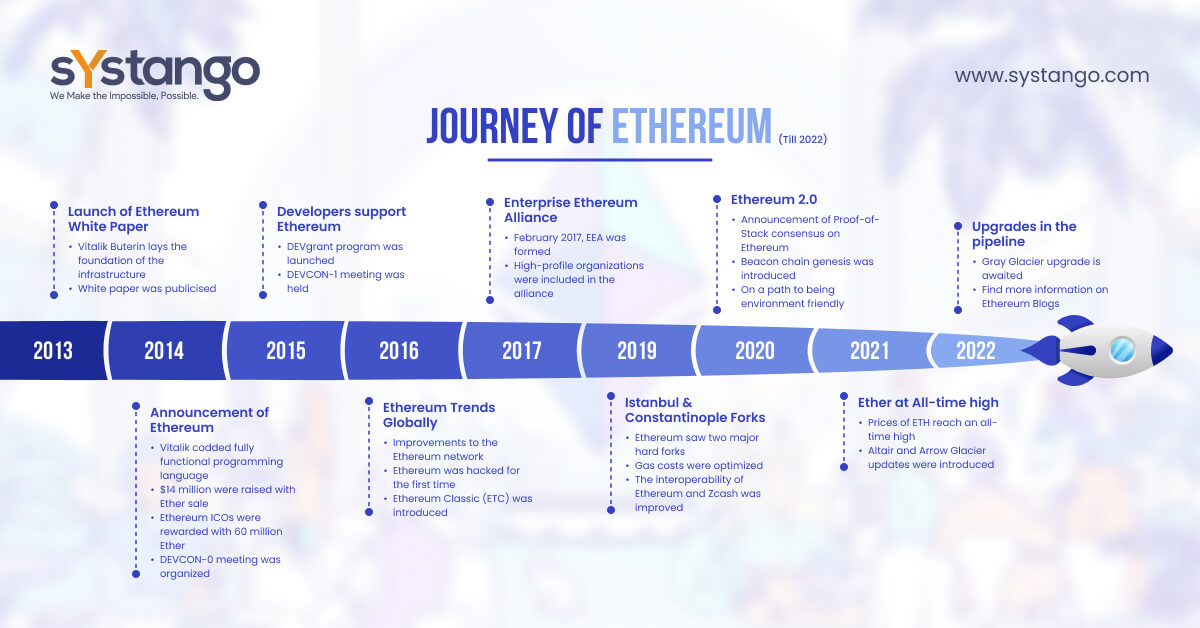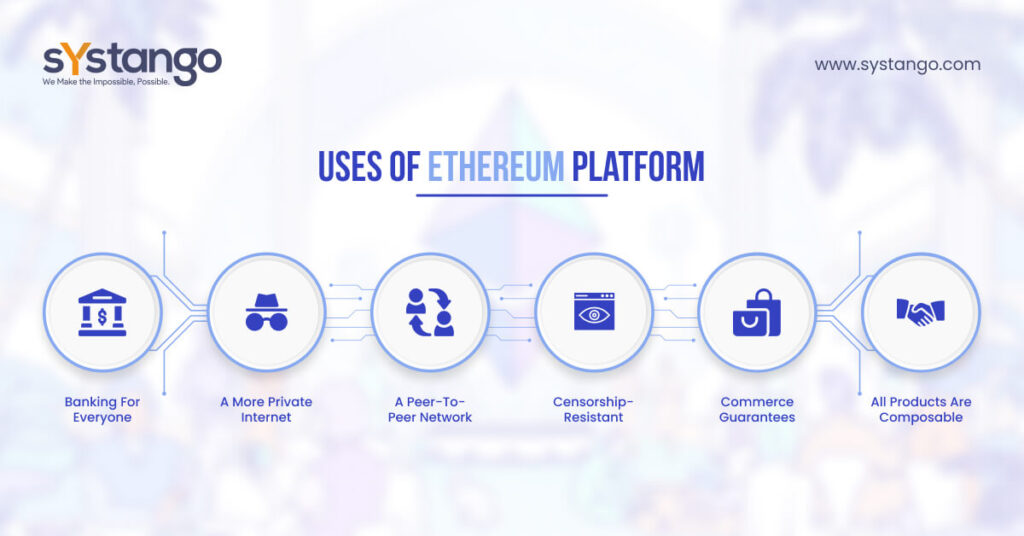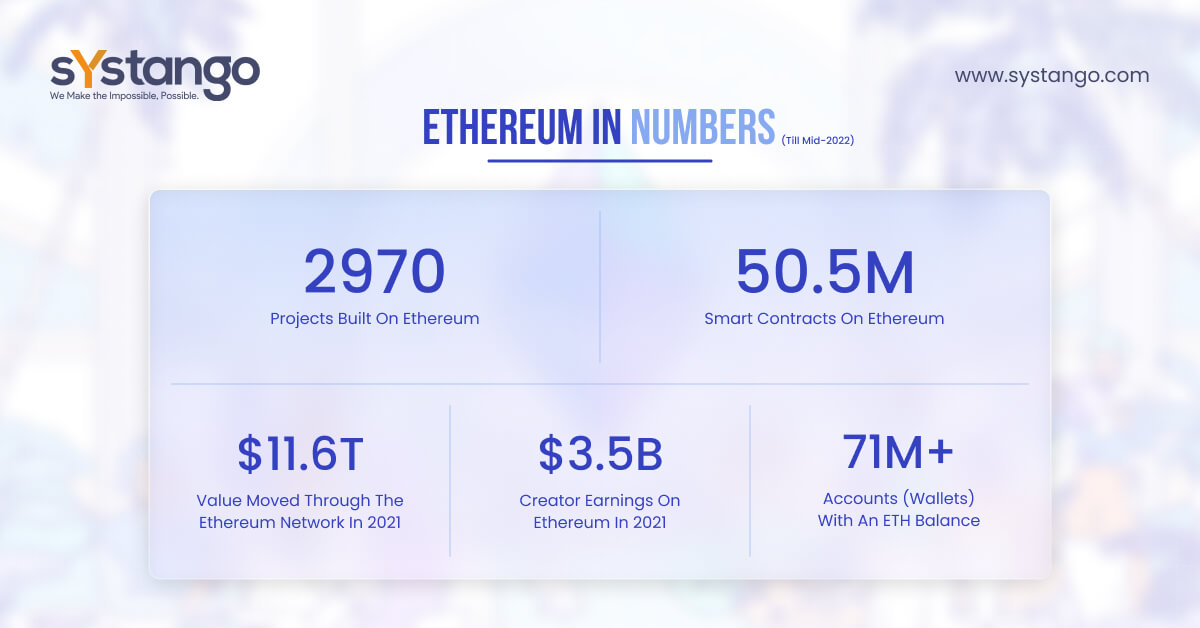All you must know about the Ethereum Blockchain Platform

Ethereum has been one of the most talked about blockchain platforms. Developers are constructing Defi projects, NFTs and whatnot! But how did Ethereum become what it is today, and how does it plan to compete with more agile competitors? We have answered your questions about Ethereum and its future in this blog.
In brief
- Ethereum blockchain network is the preferred platform for blockchain and cryptocurrency innovation.
- Smart Contracts can be developed and deployed on Ethereum
- Ethereum allows blockchain developers to create Decentralized autonomous organizations (DAOs) and Decentralized applications (dApps).
- Ethereum Virtual Machine (EVM) is the underlying technology that understands smart contracts and lets users interact with them.
- Since its launch, Ethereum 2.0 is the major upgrade for the platform, which is aimed at increasing the transaction throughput of the network.

Ethereum as a blockchain platform has been the foundation stone for decentralized finance (Defi) and is considered to be the network’s biggest achievement by experts. Many dApps popped around late 2019s and early 2020s.
The introduction of numerous DApps has marked Ethereum as the changemaker in the Defi market. However, the blockchain platform is only leveraged to process a certain number of transactions, after which the network begins to get congested. Ethereum can only process a maximum of 15 transactions per second, and with huge traffic on the network; the transactions pile up.
One of the most famous examples referred to by blockchain experts is that of CryptoKitites getting clogged with transactions pileup. The flow blockchain platform was created to resolve this scalability issue of Ethereum for CryptoKitties.
Let’s get a brief overview of the Ethereum blockchain platform and how it can be leveraged for blockchain development.
History of Ethereum
Just like any other platform, Ethereum was launched to fulfil the shortcomings of Bitcoin.
In 2013, Vitalik Buterin published a white paper, detailing automated immutable ‘if-then’ statements a.k.a smart contracts, which can be used to develop decentralized applications.
While the development of decentralized applications already existed, the introduction of the Ethereum blockchain platform intended to add platform interoperability, a key feature in the blockchain space.

How does Ethereum work?
Ethereum runs on a decentralized system referred to as Ethereum Virtual Machine (EVM).
Just like Bitcoin, the Ethereum network is also powered by thousands of computers, referred to as ‘nodes’.
How is it helpful? Since the Ethereum network does not operate on a centralized server, it runs as a decentralized network, which is highly immune to cyber-attacks and is unable to go down. Even if one computer goes down, there are thousands of others who can easily hold up the network.
Each transaction taking place on the Ethereum platform is recorded within the blocks. Mining, which is also referred to as Proof-of-Work (PoW) is done by miners to commit their computer power to the network.
A lot of miners compete to create a block on the network, once a block is created, the respective miner is rewarded with ether.
Fact: Each block on Ethereum has a unique 64-digit code.
You must note that all the transactions on Ethereum are entirely public. So, once any miner successfully creates a block, they tend to broadcast it to the rest of the network.
What is an Ethereum Virtual Machine (EVM)?
EVM is a computation software that acts as the runtime environment for smart contracts on the Ethereum blockchain platform. It can execute millions of projects simultaneously.
EVM provides a framework for developing Ethereum-based decentralized applications (DApps).
If you’re looking for a deep understanding of EVM, you’ll have a deeper understanding of computer science concepts such as stack, bytes, memory and numerous other blockchain concepts such as hash functions, proof of work, and Merkle Tree.
If you’re looking for a deep understanding of EVM, you’ll have a deeper understanding of computer science concepts such as stack, bytes, memory and numerous other blockchain concepts such as hash functions, proof of work, and Merkle Tree.
Where can Ethereum be used?
- Host Smart Contracts and Decentralized applications (dApps)
- Sell and purchase cryptocurrencies like Ether
- Exchange non-fungible tokens
- Decentralized finance activities
- Play Ethereum-based video games

What are the problems with Ethereum?
If you are into blockchain development, you might agree with the fact that Ethereum has some major development problems. Below is a brief overview of the problems that must be addressed on Ethereum:
- Rising Transaction Costs: Gas fees have become very expensive.
- High Computational Power: With skyrocketing computational power, the use of electricity is high
- Network Congestion: Transactions are being piled up
- Crypto Inflation: No lifetime limit on the number of potential coins.
What is Ethereum 2.0?
To address the scalability issues, Ethereum has announced it will be upgrading to a proof-of-stake (PoS) consensus algorithm and it would be named Ethereum 2.0.
The new chain is being referred to as Ethereum 2.0’s Beacon Chain, which will act as the coordinating hub for the network and will be responsible for introducing shard chains to the network.
We thought you might search for it, so we have answered it for you:
What is Sharding?
Sharding can be understood as a technique of spreading transactions across smaller and multiple blockchain networks. These blockchain networks run on weaker hardware, thereby requiring less computational power. Ultimately, solving major issues of congestion and scalability for Ethereum.
What is a Beacon Chain?
Beacon Chain is the coordination mechanism for Ethereum 2.0. It will be responsible for creating new blocks and also ensuring those new blocks are valid. Further, it will also assure if the validators on the network are being rewarded with ETH or not!
You can consider the Beacon chain as one big lighthouse over a network, which is constantly validating, scanning, sending out rewards, and collecting votes from and to the network.
Fact: Ethereum 2.0 is likely to reduce crypto’s carbon footprint by 99.95%.
The transition of Ethereum to PoS will not only improve its scalability, but will also help it to become a sustainable, secure, and economically durable blockchain network.

Quick Answers to Ethereum-based FAQs
Is Ethereum a Cryptocurrency or a blockchain?
Ethereum is a blockchain network and its native cryptocurrency is named Ether (ETH).
So, when you refer to Ethereum, you are referring to a blockchain platform that can be leveraged to store data and build decentralized applications. Developers and users can host applications on the Ethereum blockchain, which will be decentralized in nature.
Ether (ETH) on the other hand is the digital currency for the Ethereum platform. It is held on the platform and can be used for financial transactions on the network.
Is Ethereum better than Bitcoin?
Ethereum’s primary use is as a decentralized network that makes it possible to build and run applications, smart contracts and other types of transactions on the network. Whereas, Bitcoin has established itself as a virtual currency.
If you compare, Ethereum processes transactions quicker than Bitcoin. While Bitcoin takes around 10 minutes to validate a block, Ethereum can do it in only 12 seconds.
Another point to note is that there exist no limits on the number of potential Ether tokens, but there is a set number of Bitcoin tokens, which is 21 million. Out of these, 19 million Bitcoins are already in circulation.
How much are the gas fees for Ethereum?
The average gas fees on Ethereum mostly vary from $10-$30. But you must note, with all the ups and downs, Ethereum gas fees have also fluctuated from the highest average daily cost of $1.57 to $196.638.
If you’re curious to keep track of the gas fees of Ethereum, check this gas fees tracker.
Lastly, The Future of Ethereum
Ethereum is by far the most innovative and technologically advanced blockchain platform. Ethereum’s two primary advantages are its problem-solving capabilities and its ability to allow other developers to utilise its tokens for application development.
Ethereum’s future success will depend on its capability to become more scalable, secure, and sustainable with 2.0.
With all this said and discussed, will you care to invest in Ethereum?
If yes! Talk to our blockchain developers and crypto experts on how you can best get a return on your investment in the blockchain space!






